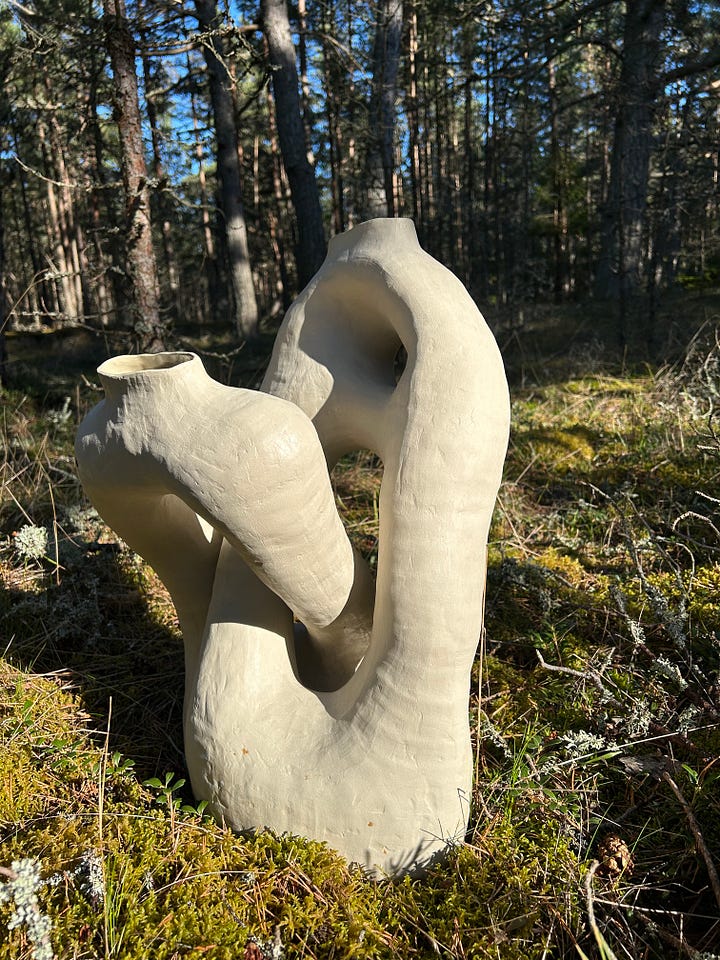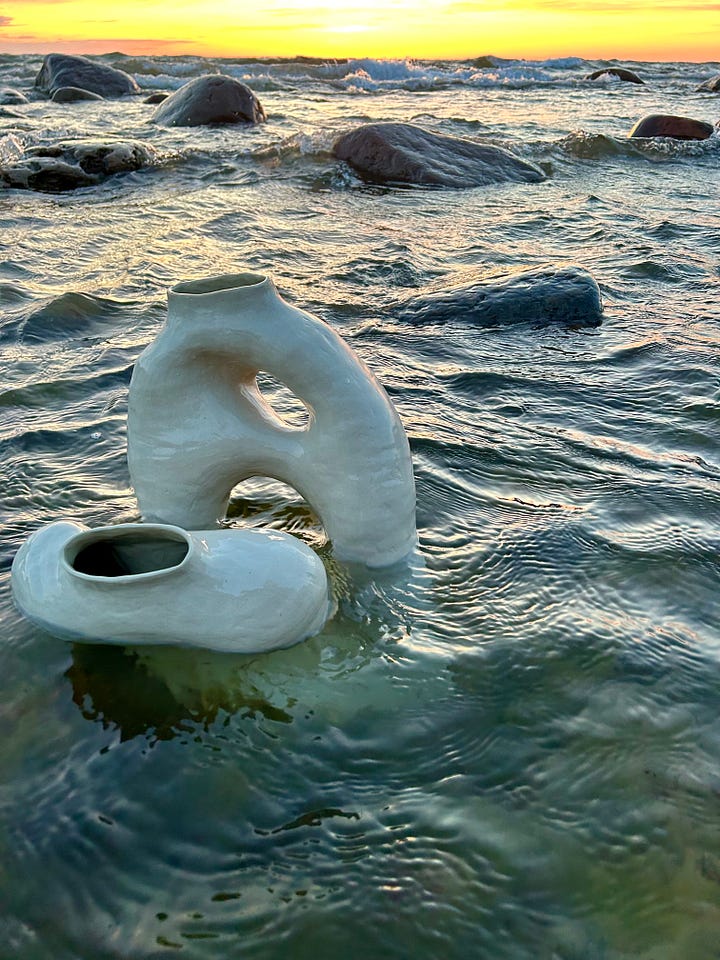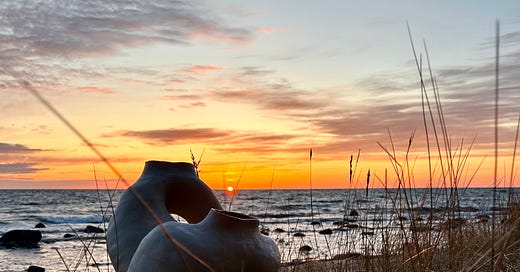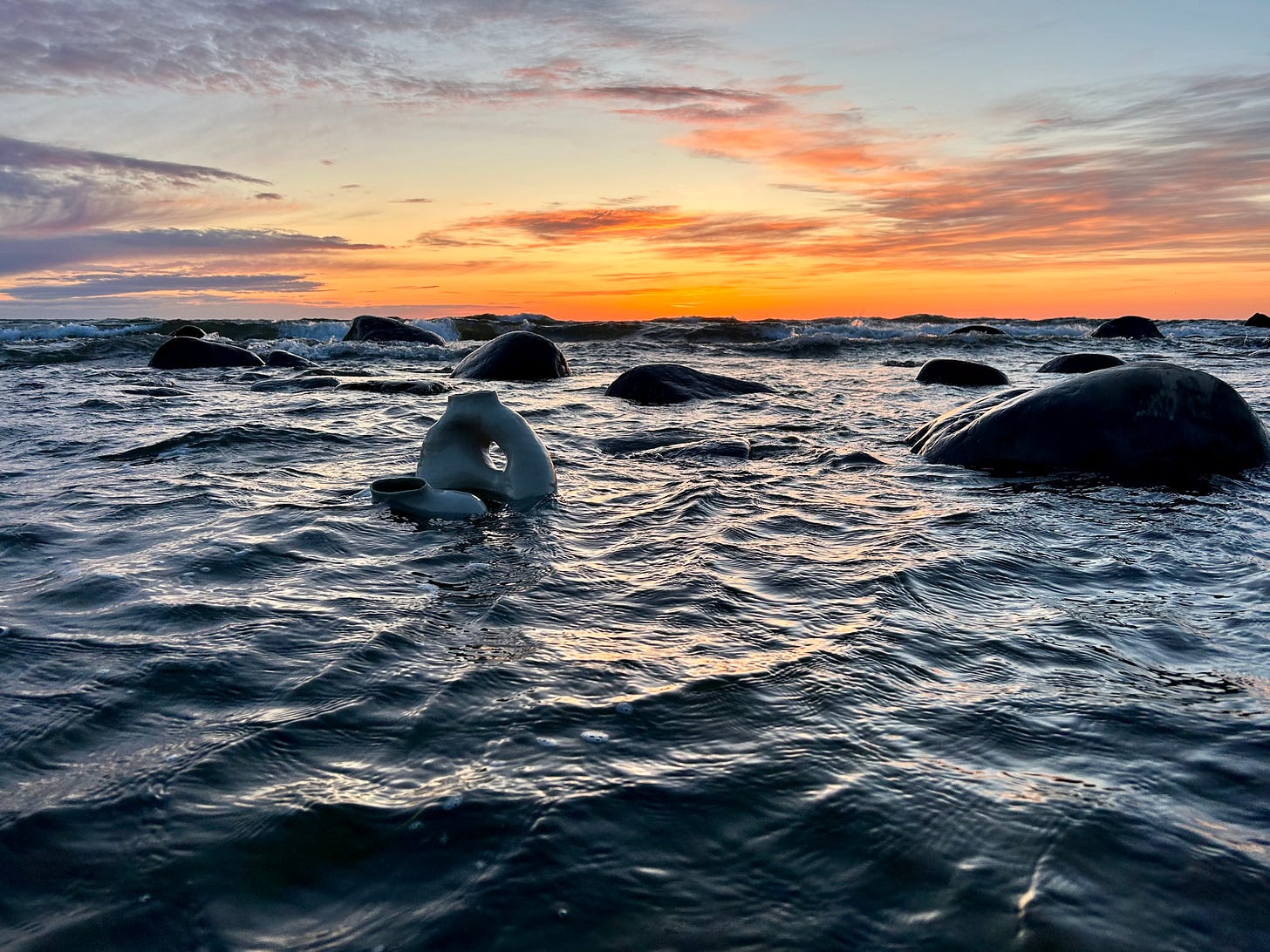I began writing this piece in November 2023 and left it for several months as my skin needed thickening again before I felt ready to share it. I did not got back and change the references of time so the timeline may feel a little off, however it is not relevant. It has been almost a year since I flew to Estonia for a self-directed artist residency. I have kept that experience largely to myself until now. Enjoy!
This week in the studio, I cleared away the small piles of ornaments in progress, the materials I used to decorate the latest (and late) batch of mug club mugs, and wiped the work table down to achieve the almost-clean a ceramic space allows. In that space I began building a new vessel sculpture. The first one in 7 months.
The residency in Estonia tested me in ways I never expected to be tried. I have not known how to begin to share all the nuances and lessons I endured in 9 short weeks. How to talk about the trust it took to fund my own residency even as I met other international artists who were working on stipends to complete their installations for the national art museum. How to persevere in a personal project I have a vision for- believing if I continue working on it, I will find the space that wants to house it’s presentation eventually. How to talk about such a deep desire to feel integrated with a country that has protected their culture as they have withstood occupation after occupation for centuries, when I have always felt an uncomfortable sense of mis-belonging in the country my grandparents fled to. How to want so desperately to learn one of the hardest languages in the world… one spoken by centuries of ancestors, and lost a single generation. The loneliness of having no one to practice speaking with, because displacement scattered family and broke ties. How to grapple with the feeling of borrowed independence, that I may never again get to spend long chapters of time completely on my own. That this trip, was possibly the last spontaneous solo trip I will ever take. How to describe being stretched between the place where I am home, with a wonderful partner, and this place I want to make home. Where I desperately want to move and study and disappear into, but I am not just me anymore. To live a life bound by the beautiful connections of other souls, is to live a life with compromise. These feelings all became too big to contain the way I hoped I would. To eloquently weave them into stories was a task I felt too meager to attempt.
At sunset, I put a Vessel in the bike’s baby carrier residing in the small cabin’s shed. As I buckled it in, I considered the irony so many creative women face- that life feels ultimately compressed into one choice: The choice to create in artistic mediums of ceramic, fiber, paint, words, metal… or the choice to create in new human life. Feeling an acute sense, that this would be the likely be the last time I would buckle the former into a bike seat, but not the latter. I began biking over pine-needled paths heading west. The ride was short but I was racing a sun that turned red and sank faster than I anticipated.
The tall trees stopped abruptly, giving way to a short bank of wild grasses and a beach covered in sand and pebbles. Of all the magnificent, titanic views I chased in my ego-driven 20s, the peaceful transition from Baltic forest to sea may be my favorite place to stand in all of the world. The beach was empty. My husband was back at the cabin, on a work call. My disappointment that I had to do this alone fell away to fate. This experience was always meant to be only mine.
The piece I brought with me was titled Heritage.
Vessel pieces, like most things in our world, are built from the bottom up. Weeks prior in the studio, I carefully mapped out the base piece of this shape, knowing I ultimately wanted it to split into two inter-twinning vessels. Knowing they would grow from the same root, but split apart. Their bodies would be linked together, but never touching. While I worked I mourned. I mourned the grandmother I never met. I mourned the family traditions that so often die when matriarchs are tragically taken from a family too soon. I mourned spending time in a place that makes my body somehow tingle with familiarity even as I feel so foreign to it. I imagined the trauma she endured, fleeing her home, a short bus ride from where I sculpted. At 20 years old she would see her parents for the last time. I think of how long ago I was 20 years old. How excited I felt for that birthday, how mature it made me feel, and how the wisdom of the next decade would teach me that at 20 years old I was, in so many ways, still a child. I mourned that she passed decades before her people prevailed. I imagined what it would be like to know her. To eat the food she cooked, feel the touches of her fingers braiding my hair, and what foreign terms and gestures of endearment would have been familiar to me. I mourned that upon my return, the ability to mend what was broken feels too abstract to grasp and reforge. The negative space between the two forms represented that tension, the tension of an energy created by always and never belonging to something.


The sun sets late in early May, but the breeze cut through what little warmth the long days provide so far north. I stripped off my clothing, the wool scarf and socks, the puffy jacket and thick leggings. The air pricked at my skin as I carried the sculpture into the sea. The initial shock of the water’s chill gave way to a cool comfort as I stumbled over submerged rocks making my way out into the shallow water. I filled it partially with sea and set it on the uneven rocky terrain below the water’s surface. The gentle waves rocked it slightly back and fourth. Knowing it was the last time I my hands would ever touch this piece, I watched it with that heightened awareness of wanting to remember a setting forever, then stumbled back to the shore.
I thought of the woman with the grandfather clock. In the Occupation Museum in Tallinn, I spend a lot of time in the “Exile Room” this room tells the story of Estonian’s fleeing advancing Soviet troops. It tells my Grandmother’s story in the impersonal broad way that is the only way of story-telling museums can muster. This room’s narration includes a detail about an elderly woman who chooses to stay on the shore among all the abandoned heirlooms. She stands with a grandfather clock, watching the last boats depart for Sweden. I do not know why this imprinted on me. Many Estonians who stayed behind mistakenly believed that US troops, the newly titled proud defenders of freedom and democracy, would come to their aide in a few days time. America, who’s policies love greed above morality had no reason to care for the poor eastern countries that were swallowed by the Iron Curtain. She straightened her new medal, turned a blind eye to the new era of mass murder and oppression that was to come, and continued raising her children to believe she is the world’s Hero. I wonder if this Estonian woman knew that the Occupation would escort her to her final days, if she would have picked arriving in Sweden empty handed over the sentiment of that clock. I wish I could sit with her, I wish I could hear her thoughts and hold her delicate hands as she weighed her options in such a pivotal moment for an entire People. I thought of all the sculptures I was forced to leave behind, experiencing a death of ego in the process that would make me question for months how to understand what “art” is when it’s true value is so private in a world that only knows how to measure in commerce and notoriety.
The sun had gone down but the afterglow still gleamed off the surface of the piece as it moved in time with its surroundings. I sat on the shore, burrowing my feet into the cold sand and watched it. I imagined the tide coming in to swallow the piece whole. I wondered if the piece would re-emerge again, and what a passerby might think spotting it in the days or weeks to come when the sleepy island awakens to summer visitors. I thought about my ancestors, if they knew I was there, if they were there also. The wind combed through my hair and the grasses whispered in the language only wild grasses can speak. I grounded my hands into the earth and wondered if the land felt me there, as much as I felt it. If it held me and cradled me the way I longed to be held by something so much larger than my own understanding.
As the light faded, I righted the bike with an empty baby carrier, and peddled back into the woods now filled with dark shadows. My body had been chilled to the bone, but a warm sauna awaited me and I understood in those bones why this ancient ritual was such a sacred and prevalent practice for the people living this far north throughout time.
How?
How was I ever going to share all this? I could not even find a way to share the experience with the person closest to me upon my return minutes after it happened. To hope to encapsulate the experience with words and pictures would be as foolish as trying to capture the rhythm of the tide by scooping the seawater into a jar. The journey of the Vessels created in Estonia, became too large to contain within my own understanding: the feelings they represented in their creation, and the way they tested my validity as a working artist when after investing thousands of dollars to be in the space to create them, I simply could not afford to ship them home.
There was a humored irony, in having to make the gut wrenching decision to leave my work behind. While in Estonia, I became newly enraptured by performance and installation art. In this capitalist world, I wanted to be surrounded by feelings and concepts and ideas. I wanted to share and receive life changing memories. Not physical objects. For this residency to end in a performance witnessed only by me and shared with my sweet partner who held space for my tears, was a cruel and romantic trick. A full circle moment… two generations later. Leaving a piece of me behind, but pieces that will be forgotten in the beautiful way only surrender can deliver.
To have nothing and something at the same time is a personal revolution.
With love and awe-
Kirsten






This is a beautiful and moving essay. I can only imagine the power and impact of leaving the vessel behind, and I'm so thankful you shared it with us.
This was a stunning personal essay! I'm sorry that vessel couldn't make it home with you, but sounds like it made it to the home it was meaning to go to.